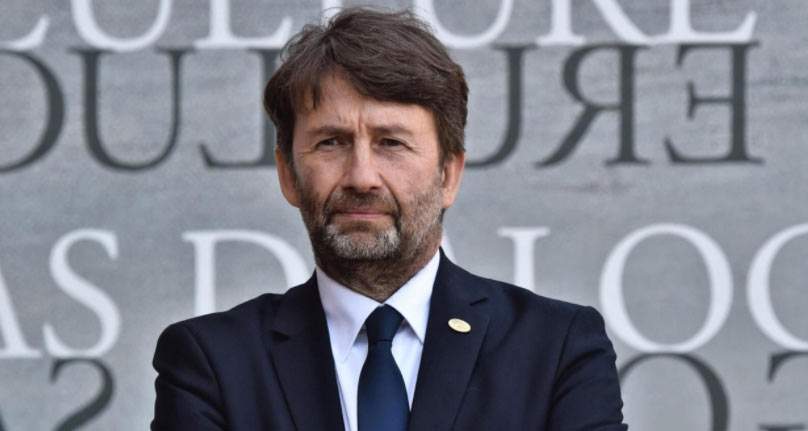Franceschini: Big businesses that don't invest in culture should be ashamed of themselves
During the presentation of the exhibition Grand Tour. Dream of Italy from Venice to Pompeii, set up at the Gallerie d’Italia in Milan ’s Piazza Scala and open to the public from November 19, 2021 to March 27, 2022, Culture Minister Dario Franceschini spoke, touching on various topics: above all, the importance of large companies investing in culture, the graft of contemporary architecture in historic centers, and finally the model of tourism to follow.
"Intesa Sanpaolo,“ Franceschini said, ”has been investing in culture for many years, it believes in culture. Article 9 of the Constitution, which commits to protect the nation’s historical and artistic heritage and landscape, is not only addressed to public institutions, but to all citizens, and in particular to those who have an important task such as large companies, large institutions, and private individuals. I believe that from this point of view Intesa Sanpaolo has shown a path that is in the groove of a tradition that has been very important for our country: the very collections of Intesa Sanpaolo came from the intersection of collections of individual banks that have gradually, by incorporation or merger, come to constitute a large collection. Think of how much good the banking foundations in their territories have done over the years to the country’s heritage, investment in culture, and protection of heritage: so many Italian collections of works of art that later became public and entered state museums or private museums were born from this awareness. When there was no corporate social balance sheet assessment yet. However, there was a kind of social balance sheet of how much they had invested in their territory, how much they had financed cultural activity. Intesa Sanpaolo identified this path. I think it has done many important things for the country, many relevant things that have left permanent traces. One of these important traces,“ the minister continued, ”is to have shown that even when you are a great banker or a great professional, there is a relevant part that you have to give back to the country by investing and believing in investments in culture.
We have made important, new regulations. I saw theArt Bonus data yesterday: we have come from 2015 to now to 590 million donations, which is an important figure, but it is little. It’s a figure that comes from donations from big companies, crowdfunding donations; it takes time for it to enter the country’s tradition, but I would like to see it come quickly to the point where big companies that don’t invest in culture are ashamed not to present it in the company’s social report."
Franceschini then shared his opinion on the grafting ofcontemporary architecture into historic centers, "I think we are a country that won in the 20th century the battle of the protection of historic centers and we should be proud of that, however, at the same time something happened. In a country that is wonderful and unique in the world, because it has seen styles settle and cross over each other, so the Middle Ages fit on antiquity, the Renaissance on the Middle Ages, the Baroque on the Renaissance and it is a succession of intersections (our churches and palaces are beautiful because their style does not denote, as in other countries, only the time when the country was great; because Italy has always been great, it all intersects and overlaps; beauty comes from the overlap), I wonder: why did we stop? Why did we stop in the second part of the twentieth century and it seemed that investing in contemporary architecture, in grafts, was somehow violating protection? Why don’t we have to imagine having grafts in historic centers? To fill urban voids, instead of leaving them empty, grafting great contemporary architecture is a way to continue this enrichment. We have the great masters, the young talents. This is the challenge not only of Milan, but of the whole country."
Speaking about the theme of the exhibition, he finally took the opportunity to address the issue of the tourism model to be followed in Italy. “The theme of this beautiful exhibition that has collected masterpieces from Italian museums and foreign museums in a very important collaboration between public and private,” the minister concluded, "introduces the theme of the Grand Tour. We should be proud to think that generations and generations, for a few centuries, in order to form themselves and to complete their education had to come to Italy. I think there is an indication from this point of view as well: tourism will come back, it has already partly come back; it will come back as impressive as before and with even stronger numbers, and with even bigger concerns, because until 2019 we were talking about overbooking, about entrance fees to some places in Italian art cities, about overcrowding. What kind of tourism do we want? The low-cost tourism, the one that does not deepen, does not consume, does not even bring wealth, passes and goes, or vice versa the cultured tourism, made up of travelers, of people who are able to come, to understand, to immerse themselves in an authentic experience, to respect the fragility of our historical and artistic heritage? This we have to bring, make Italy known, make it all known, and invite people to come to Italy to educate themselves."
 |
| Franceschini: Big businesses that don't invest in culture should be ashamed of themselves |
Warning: the translation into English of the original Italian article was created using automatic tools. We undertake to review all articles, but we do not guarantee the total absence of inaccuracies in the translation due to the program. You can find the original by clicking on the ITA button. If you find any mistake,please contact us.





























